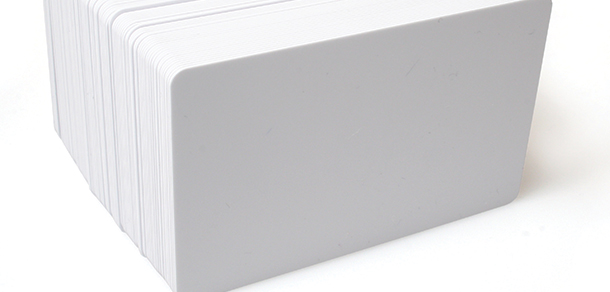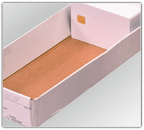Axing PVC from high-security documents
Issuers finding advanced card materials worth the added investment
22 August, 2016
category: Contactless, Corporate, Financial, Government, Health, Smart Cards
Good old polyvinyl chloride. It’s the primary material in the vast majority of IDs, payment cards and the like. But it’s also not secure, has long-term durability problems and is readily available to counterfeiters – $35 will get you 500 blanks on eBay.
There are many problems with PVC. Card issuers – federal and financial alike – want a longer lifespan from cards, and PVC is only able to provide so much durability. Then there’s security concern, which as brought to the public consciousness as news spread of students buying near-perfect fake driver licenses from China. Lest we forget, there are also environmental concerns with PVC. All these are reasons why it’s time to deprecate PVC as the primary material for government-issued identity, access control and payment cards and make the move to composite cards utilizing advanced card materials.
PVC vendors will say their credentials can last up to five years or longer, but large-scale testing of PVC-only cards hasn’t been done in more than a decade
Composite cards still use PVC, but in much smaller quantities. Using a PVC core with other materials such as polyester, Teslin and polycarbonate can add strength and security to the credential. “Every card material has its strengths and weaknesses,” says Pierre Scaglia, global segment manager for Secure Credentials at PPG Industries.
The trick is finding the right composite materials that suit the credential’s specific needs, Scaglia explains. “If you want a five-year, dual-interface card, PVC isn’t strong enough to do that,” he says. “You need to adopt other materials as well.”
The biggest downside for PVC is durability, experts say. As they spend more money embedding electronics, issuers want longer life out of the credentials. PVC vendors will say their credentials can last up to five years or longer, but large-scale testing of PVC-only cards hasn’t been done in more than a decade, says Dave Tushie, technical and standards representative at the International Card Manufacturers Association.
Tushie was part of the testing conducted between 2000 and 2003 that looked at the durability differences of PVC-only card bodies versus various composite card types. Durability and bend testing found that 75-80% of the PVC-only card bodies registered as failures versus a failure rate of just 20% for the composite cards.
At that time durability needs were less demanding – two to three years for payment cards and four to five years for driver licenses, Tushie says. Issuers now want a longer lifespan.
This testing was conducted a long time ago and improvements in PVC have been realized, but it’s hard to tell how much better they’ve become since there hasn’t been any open testing, Tushie says. And while PVC vendors may have improved the durability of their materials in the last decade, manufacturers of other materials have been doing the same.
MorphoTrust provides driver license issuance systems and works with states on how best to issue the documents. The vast majority of states that the company works with have moved away from PVC-only credentials in favor of composite cards, says Roland Fournier, senior marketing program manager at MorphoTrust. “Five-year durability is the maximum you can expect with PVC, but with composite cards you can get seven or eight years,” he explains.
That’s not to say PVC is without its uses among next generation credentials. Adding other materials can strengthen PVC adding durability and security, Tushie says. “It’s amazing how little polyester you need to put into a card to improve the durability,” he explains. “You can have composite card with a PVC core and other materials on the outer layer and you get remarkably improved performance.”
PVC is commonly available to anyone who wants it. From a security standpoint, this makes it a nightmare for an issuer.
There was a flex test with a PVC core card that featured a polyester overlay that survived 200,000 flexes in a testing scenario, Tushie says. The ISO standard for successful a flex test requires only 50,000 repetitions. “We stopped the test because there were no failures,” he adds.
Security
Another issue with PVC is the ease of obtaining the material, says Fournier. “The material is commonly available to anyone who wants it,” he explains. “It’s a nightmare for an issuer.”
Adding polyester, Teslin or other materials makes it harder to counterfeit a document, Fournier says. But adding these materials adds complexity and costs to the manufacturing and personalization processes. Composite cards are more expensive but if an organization is issuing enough they can realize economies of scale, Fournier says.
“If an issuer has an existing process and they choose a new material, they have to make sure it works with their existing equipment,” he explains. “The new material has to work well with existing personalization technology.”
There are some changes that also have to be made to the manufacturing process, Tushie says. Sometimes the materials have to be orientated on the core material a certain way, which can take extra time. Some overlays may also require slightly different temperatures in order to adhere properly.
And when it’s all said and done, the additional cost of materials, personalization and changes to processes may prove too much for some issuers. “They can be a little more reluctant if they think they have a stable process in place now,” Tushie says.
Environmental concerns
Another reason to stop using PVC or decrease its use in credentials is the environmental impact, Fournier says. Creating PVC yields a lot of environmental waste. “Getting the raw materials for PVC carries a stigma and some issuers started shying away from it because of the environmental impact,” he says.
As issuers want longer life, better security and an environmentally friendly credential, it may be time to move away from PVC – or at least deprecate its use – and start looking at composite materials that better fit the needs of issuers.




